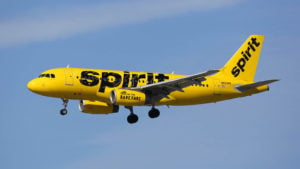Despite warnings against mass travel issued by the Centers for Disease Control and Prevention, many Americans ignored such requests. In fact, as CNN recently reported that the Transportation Security Administration screened 1.17 million air passengers, a single-day record since the novel coronavirus pandemic began. At first glance, this appears to bode very well for travel stocks.
As the mainstream media constantly reminds us, we’re in the middle of a massive surge in new Covid-19 cases. At time of writing, the seven-day average of new daily infections is just under 160,000. Presumably, this figure will skyrocket as the uptick in travel and close contact with others raises overall vulnerability. As well, we’ve seen more than an average of 1,000 people succumb to the coronavirus over the past few weeks.
Yet that doesn’t seem to bother nearly as many people as you might assume, which initially appears a huge relief for travel stocks. Apparently, the power of cabin fever combined with Covid fatigue is enough to overcome fears of the pandemic. And sure enough, when you consider the probability of dying from SARS-CoV-2, the chances are incredibly slim.
Still, I wouldn’t go overboard on travel stocks just yet. According to data from CouponFollow.com, while Americans are eager to travel, many households have made drastic changes to their traveling methods due to Covid-19. Most notably, a majority (or 54%) plan to travel by car for the holidays this year, while plane and train travel represent 34% and 11%, respectively.
Further, Americans prefer to travel by car because of coronavirus fears, even when the travel distance increases significantly. For instance, slightly more than two-thirds of travelers prefer driving when the journey is less than 300 miles, which isn’t surprising. However, even when the distance is over 300 miles, a majority prefer cars over planes.
To give you some context, the distance from Los Angeles to Salt Lake City, Utah is about 690 miles, or nearly 11 hours of driving. From LA to Albuquerque, New Mexico is just under 800 miles, or 12-and-a-half hours of driving. If anything, it’s time to be skeptical about these travel stocks:
- American Airlines (NASDAQ:AAL)
- Spirit Airlines (NYSE:SAVE)
- Hawaiian Holdings (NASDAQ:HA)
- Park Hotels & Resorts (NYSE:PK)
- Comcast (NASDAQ:CMCSA)
- Ruth’s Hospitality Group (NASDAQ:RUTH)
- Lyft (NASDAQ:LYFT)
To be fair, there’s a case to be made that this pandemic is on its last legs. Additionally, people eventually acclimate to their environment. That might be true. However, consumer sentiment indicates that people are shifting their purchasing behaviors and not necessarily in a manner conducive for leisure. Therefore, certain travel stocks may face downside risk before their trajectory improves.
Travel Stocks to Sell: American Airlines (AAL)

It doesn’t take a rocket scientist to understand why the airline industry crumbled amid the coronavirus outbreak. However, as we near the dubious one-year anniversary of the global crisis, people everywhere have gradually adjusted to the new normal. In theory, this should help support American Airlines. Indeed, AAL stock has jumped over 27% in the trailing six-month period.
But is that enough to justify travel stocks exposed to the airliner industry? Of course, air travel itself will be a viable business. Unless we invent a new form of global transportation, flying remains the most convenient and often times cost effective method. However, the sector could become a game of musical chairs, not unlike what we’re seeing in the oil market. That wouldn’t bode well for AAL stock, which has a huge debt load relative to the competition.
Moreover, how would that debt load impact its ambitions post-pandemic? More than likely, the competition will be eager to aggressively push promotions and routes to claw back lost revenues. But American Airlines won’t have as much leverage than its rivals. That makes AAL stock risky, even if other travel stocks pick up based on consumers shedding Covid-19 fears.
Spirit Airlines (SAVE)

On the surface, Spirit Airlines should be one of the travel stocks to buy. If the coronavirus was just a matter of a health risk, deciding which airliner to buy might as well be a blind wager. However, because this is an economic crisis, SAVE stock stands out positively. After all, if travelers have already gotten over their fears of Covid-19, then the only hurdle they must traverse is the financial one.
Further, that’s what data from CouponFollow.com suggests: “64% of travelers said they’ve budgeted more money for travel this year than they did last year.” While that’s encouraging, on the flipside, “23% of people said they can’t afford to travel this year.” In other words, the economy for Spirit Airlines’ target demographic has gotten significantly weaker. Logically, this would likely be a headwind for SAVE stock.
Another factor to consider is the possible K-shaped economic recovery. This crisis has resulted in a bifurcated environment where the well to do have enjoyed a budget increase (i.e., no commuting), whereas lower-income households have badly struggled. If the rich represent the most air passengers, they may opt for airliners that can provide superior services.
Hawaiian Holdings (HA)

Among travel stocks, Hawaiian Holdings may actually hold the dubious distinction of garnering the most skepticism. Under any other circumstance, Hawaii is a dream destination, a literal island paradise. All other things being equal, such a place might be the ideal location for waiting out the coronavirus pandemic. Naturally, that’s exactly what Hawaiian officials realized, thus implementing strict travel protocols.
Unfortunately, Hawaii’s actions don’t occur in a vacuum. By that, I mean Hawaii’s economy is substantially tied to tourism, with the industry accounting for roughly 23% of local economic activity. But with Covid-19 fears spreading everywhere, few people wanted to up and travel to the island state. Of course, this has been devastating for HA stock.
Fundamentally, the crisis will continue to weigh disproportionately on Hawaiian. According to the Bureau of Transportation Statistics, the average passenger load factor for all American carriers was 49% in August. For Hawaiian Airlines, it was a devastating 23.7%.
Back in 2019, the average load factor for the beleaguered company was over 87%, in line with other airliners. Put another way, rising Covid-19 cases is no laughing matter for HA stock.
Park Hotels & Resorts (PK)

Another example of travel stocks that seemingly should do well in the present environment is Park Hotels & Resorts. As I stated earlier, a post-coronavirus record number of travelers hit the road and the friendly skies over Thanksgiving weekend. In theory, this should bode well for PK stock. Park Hotels & Resorts is a real-estate investment trust specializing in high-profile lodgings.
While shares have jumped higher over the trailing month — we’re talking about 60% up — prospective investors should be cautious. True, rich people are traveling but just as many are staying home. As evidence, you can look at the meteoric rise of Peloton Interactive (NASDAQ:PTON) during this Covid-19 pandemic. Yes, affluent people have access to gym memberships but they’re eschewing that for at-home exercise equipment.
In addition, the overwhelming use of personal vehicles over air travel suggests that many traveling consumers are on a budget. Plus, they might be more sensitive to Covid-19 fears; hence, the method of travel.
Therefore, hotel investments like PK stock might not fare well if coronavirus cases worsen. And the price point that the underlying lodgings command makes it out of the question for many travelers.
Comcast (CMCSA)

If I had to cast a vote for worst governor in the history of the United States, my vote would go to none other than California’s Gavin Newsom. If you like him, it’s probably because you don’t live in California. He and the activist arm of the Democrats appear hellbent on destroying the state’s economy by considering more draconian stay-at-home orders.
Of course, the rules don’t apply to Gavin Newsom. But they do apply to businesses of every size, including massive ones like Comcast. And that is going to be a tricky problem for CMCSA stock.
In the pre-Covid days, Comcast represented one of the more viable travel stocks. With prime theme parks located in almost-always sunny California (and Florida during non-hurricane seasons), CMCSA stock at the right price offered a solid anchor for your portfolio. But with California-based assets shut down, this was a shock to the system.
True, Comcast isn’t as heavily levered to theme parks as rival Disney (NYSE:DIS). But over the long term, Disney’s arguably more enviable entertainment brands provide a comparatively robust pathway to recovery. Therefore, investors ought to be careful, especially if cases worsen nationwide.
Ruth’s Hospitality Group (RUTH)

As one of the premiere restaurant companies, Ruth’s Hospitality Group generally enjoyed positive returns for three-quarters of President Trump’s administration. Thanks to record-low unemployment across most demographics, RUTH stock benefitted tremendously from this most bullish of bull markets. Sadly, not even Ruth’s wealthy clientele could save shares from the destruction seen in other travel stocks.
A New York Times article this past summer helps explain why. According to the report, the top 25% in income level reduced their spending the most during the initial onslaught of the coronavirus. This action invariably left out service workers in the cold, who depended on their patronage. Therefore, we can assume that a similar headwind impacted RUTH stock.
After all, when you’re in one of these swanky restaurants, it’s not just about the food that makes the place special. It’s a moment to be seen by others, a hallmark of great financial success. With that element gone, Ruth’s business took a hit. Moreover, with many people traveling on a budget, they’ll likely eschew Ruth’s for any old eatery.
Lyft (LYFT)

Prior to the pandemic, the ride-sharing sector represented one of the most promising travel stocks. Suddenly, anybody with a properly functioning car and a smartphone could become a taxi driver and on their terms. The creation of a new revenue channel that is conveniently available to all initially boosted interest in companies like Lyft. However, the pandemic was exactly what LYFT stock didn’t need.
As people began sheltering in place, the ride-sharing sector careened to a halt. Even after the initial recovery from the March doldrums, LYFT stock meandered aimlessly for several months. However, with the electoral victory of Joe Biden (though this is still contested, to be fair), LYFT finally enjoyed price action worthy of its ticker name.
Unfortunately, recent sessions indicate that shares may have some problems moving higher. As I pointed out earlier, consumer data indicates that many people are traveling by car, even for incredibly long distances. That’s hugely problematic for Lyft as demand for air and train travel take a backseat. Although shares may eventually recover, the current circumstances warrant caution.
On the date of publication, Josh Enomoto did not have (either directly or indirectly) any positions in the securities mentioned in this article.
A former senior business analyst for Sony Electronics, Josh Enomoto has helped broker major contracts with Fortune Global 500 companies. Over the past several years, he has delivered unique, critical insights for the investment markets, as well as various other industries including legal, construction management, and healthcare.
